| Longisquama Fossil range: Early Triassic | |
|---|---|
 Artist's hypothetical restoration of Longisquama insignis. | |
| Scientific classification
| |
|
Longisquamidae | |
|
Longisquama | |
| |
Longisquama insignis (meaning "long scales", in reference to long structures that appear to grow from its skin) is the type species of a genus of extinct lizard-like reptile known from a poorly preserved and incomplete fossil. It lived during the Early Triassic Period, 240 million years ago, in what is now Kyrgyzstan. Longisquama was originally discovered by Russian paleontologist A. Sharov in 1969, and is known from a type fossil specimen; a crushed slab and counterslab (PIN 2548/4 and PIN 2584/5) on which only the front portion of the presumed thecodont is preserved, and five referred specimens of possible integumentary appendages (PIN 2584/7 through 9). The specimen is in the collection of the Paleontological Institute of the Russian Academy of Sciences in Moscow. The fossil was initially identified as having scales, not feathers, hence it's name. The fossil was then locked away in a drawer in the Orlov Museum until the fossil, along with several others, went on a traveling fossil show in 1999, and interest was re-ignited due to the creatures presumed feathers.
Because of its supposed bird-like traits, Longisquama was at the center of the still-ongoing debate over whether birds evolved directly from dinosaurs. Longisquama has been interpreted differently by different researchers, and is at the center of a large and heavily publicized debate about the origin of birds and feathered dinosaurs, as well as whether or not Longisquama is an archosaur or not. Up until Terry Jones's 2000 paper, it was generally accepted that birds had evolved from some form of theropod dinosaur, likely during the Early Jurassic, temporarily uprooting the theory that Archaeopteryx was the world's earliest bird. To some, Longisquama is the gliding, cold-blooded, proto-bird predicted by Heilmann's hypothetical "Proavis" in 1927, and it proves that birds are not dinosaurs. To others it is an ambiguous diapsid preserved on a group of fern fronds and has no bearing on the origin of birds.
Anatomy[]
Head[]
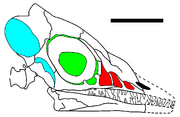
Reconstruction of the head of Longisquama. Head openings: cyanogen - the upper and lower speed ral window; green - eye opening with Skleralring; red: Antorbitalfenster; black - nose opening. Changed after Peter (2000). Yardstick: 1 cm.
Longisquama's head is characterized by the strongly extended edge of the upper temporal fenestrae window (an opening behind the eye). Sharov described two characteristics, which for Archosauria, to which crocodiles and dinosaurs also belong: a head window, which is between eye and nose opening (the Antorbital foramen), as well as an opening in the lower jaw (the Mandibular foramen). The presence of these openings and the systematic allocation derived from it became, among other things from Unwin & Benton (2001), doubtful. [1] Jones et al., however, (2001) confirmed that the Antorbital foramens were present.[2][3]
Teeth[]
Longisquama was a small, aboreal, (tree-inhabiting) insectivore, whose pointedly curved teeth were suitable for cracking the chitinous exoskeletons of insects.
"Plumes"[]
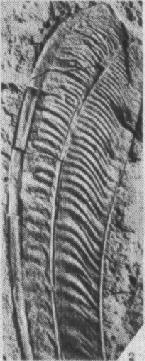
Close-up of one of the proposed Longisquama "feathers".
Longisquama had relatively highly developed shoulder belts. If the presumed extended plume sheds actually enabled Longisquama for gliding flight, they could have particularly proven during the progressive movement from tree to tree as favorable. Otherwise they could have served the deterrence of enemies or the exhibition (when part of the mating behavior).
The structures are arranged in a spacing of one per rib bone along the back, which is an unusual coincidence if the structures are feathers, however further reasearch and analysis is needed for a determinate conclusion. If the structures along the back of Longisquama are indeed feathers, they represent a feather morphology not seen in any other animal in the fossil record or extant, as the "feathers" are considerably long, reaching up to 15 cm in length, are placed along the spine, and are laid out sideways along the ribcage.
Taxonomy and systematics[]
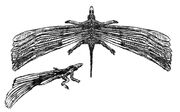
Hypothetical view of Longisquama.
A vast majority of dinosaur and bird researchers, who use cladistic methodology to determine relationships among animals, consider birds to be a specialized branch of dinosaurs that evolved from an animal similar to Velociraptor. However, a few paleontologists, notably Larry Martin, Alan Feduccia, and Steven Czerkas, contend that birds evolved from an archosauromorph ancestor similar to Longisquama, and that the apparently bird-like dinosaurs such as Velociraptor are in fact birds and not dinosaurs at all.[4]
Some paleontologists, such as Holtz, believe that Longisquama was not an archosaur becuase of the lack of specialized vertebra that usually charcterize archosaurs. The fossils of Longisquama are notoriously known for being incomplete, as not fossils of the hands of feet have been uncovered, which further compounds the difficulty in classifying this reptile.
The skeletal features of Longisquama are equally difficult to diagnose and, as a result, Longisquama has been placed as a close relative to many different Sauropsid groups. Sharov (1970) determined that it was a "pseudosuchian" (a derived Archosaur) on the basis of two features - a mandibular fenestra and an antorbital fenestra. Sharov's original description also includes an elongate scapula. Jones et al. (2000) see Longisquama as an archosaur, adding to Sharov's two characters a furcula. Olshevsky believes that Longisquama is an archosaur and, moreover, an early dinosaur - a possibility which could actually dispense with almost all of the debate, were it true. Unwin & Benton (2001) didn't think it was possible to diagnose the crucial fenestrae; the holes could just be damage to the fossil. They agreed with Sharov that Longisquama has acrodont teeth and an interclavicle, but instead of a furcula they saw paired clavicles. These features would make Longisquama a Lepidosaur, and that would mean it is not an Archosaur and, thus, not closely related to birds.
Jones et al. (2001) assumes the proof of a Antorbital fenstrae (a head opening lying before the eye socket) justifies the classification of Longisquama into Archosaur group. In contrast to Peter's (2000), some paleontologists conclude that the Antorbital fenstrae of Longisquama unites other Diapsids, and is not necessarily a characteristic of the affiliation to the Archosaurs.
Feather controversy[]
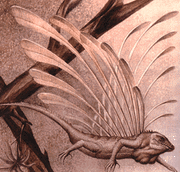
Outdated, early restoration of Longisquama.

Skeletal reconstructions of Longisquama.
The Longisquama fossil appears to have feather-shaped structures attached to its body. Investigators have interpreted these structures in a variety of different ways. It was once thought that the "plumes of feathers" were in a pattern akin to gliding lizards like flying dragons and Kuehneosaurus, perhaps even allowing it to glide, or at least parachute. Another set of plumes from the skull may have confused earlier workers. One author has proposed that a great deal of soft-tissue and in fact, impressions of missing bones are scattered throughout the specimen, so that nearly the entire skeleton is preserved despite the specimen appearing to taper off the slab[5].
paleontologist Robert Bakker once proposed that the structures were thermoregulatory, aiding in absorption or release of heat, similar to structures found in Spinosaurs, such as Suchomimus and Spinosaurus, and Pelycosaurs such as Dimetrodon and Edaphosaurus. Haubold and Buffetaut (1987) believed that the structures were long, modified scales attached in pairs to the lateral walls of the body, like paired gliding membranes. Unwin and Benton (2001) interpreted them as a single, unpaired, row of modified scales that run along the dorsal midline. Jones et al. (2000) interpreted them as two paired rows of structures that are anatomically very much like feathers, and which are in positions like those of birds' spinal feather tracts. Feather development expert Richard Prum (2001) and also Reisz and Suez (2000) see the structures as anatomically very different from feathers, and think they are elongate, ribbon - like scales. Other observers (Fraser, 2006) believe that the structures are fern fronds which were preserved along with Longisquama and misinterpreted. This last opinion is perhaps reinforced by the fact that several fossils of the structures have been discovered in no association with animal fossils.
Haubold and Buffetaut published a reconstruction of Longisquama with plumes in a pattern akin to gliding lizards like Draco species and Kuehneosaurus, allowing it to glide, or at least parachute. Though this is now thought to be inaccurate, versions of this reconstruction are still often seen on the internet and elsewhere.
Debate[]
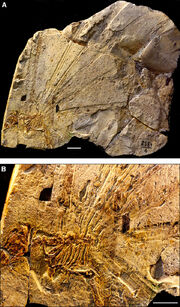
The debate about Longisquama is one of the most interesting and, certainly, most acrimonious, in all of science. The persistence of this debate raises issues about what are and are not proper methodologies in science, about standards of evidence and credibility, and the inevitable intrusion of emotional investments into human reason. This debate calls into doubt the very objectivity and empiricism of anatomical interpretation. It also shows an uncomfortable relationship between the professional conduct of science and the popular press, where very different standards of evidence are used.
A consensus of workers in paleontology is persuaded by the hypothesis that birds evolved from advanced theropod dinosaurs. The scenario for this hypothesis is that early theropod dinosaurs were endothermic, and evolved simple filamentous feathers for insulation. These feathers later increased in size and complexity and then adapted to aerodynamic uses. Scientists in this camp usually regard Longisquama as a curious diapsid with specialized scales, ambiguous skeletal features, and no real implications to bird evolution (See Feathered dinosaurs)
But a few scientists prefer the hypothesis that birds evolved from small, aboreal archosaurs like Longisquama. They see these as ectothermic animals that adapted to gliding by developing elongated scales and then pennaceous feathers. The high energy demands of gliding drove the animals to become endothermic and then feathers would be coopted for insulation as well.
Both camps draw support from analysis of recent fossil evidence (see Feathered dinosaurs).
This basic debate is over thirty years old but there are some new twists. (see Origin of bird flight)
The discovery of the Dromaeosaurid Microraptor, a small dinosaur with simple filamentous feathers as well as the long flight feathers characteristic of birds, had major ramifications for the debate about what sort of animal might be the most probable ancestor of birds. Researchers like Padian (1985) had hypothesized a running, terrestrial, dinosaur developing feathers and the ability to flap, and Martin and Feduccia were particularly critical of that idea. But Microraptor was interpreted by Xu et al. (2003) as a small, arboreal, gliding dinosaur, thus going beyond the former terrestrial dinosaur/arboreal archosaur opposition.[6]
For decades Martin asserted that the anatomical similarities between Dromaeosaurid dinosaurs and birds were mere convergences, and not credible evidence of a close relationship. But in 2004, in response to Microraptor, Martin proposed that Microraptor is a close relative of birds after all but that it, along with all maniraptoran dinosaurs, were not dinosaurs at all.[7] He proposed what he called a "comprimise" hypothesis that all maniraptorans are instead flightless birds, in a scenario where birds evolved from a Longisquama - like basal archosaur first. Martin credits this hypothesis to Gregory S. Paul, but Paul is a strong advocate of the relationship of dinosaurs and birds, and believes that maniraptorans are dinosaurs.[8]
Moreover, if Olshevsky is correct and Longisquama is an early dinosaur, then it may be an ancestor of Microraptor, Longisquamas feathers could be homologous to those of birds, and all three could be dinosaurs.
It is possible that new fossils of Longisquama could one day be found, and that these could help clarify the phylogenetic relationships.
Alternate interpretations[]
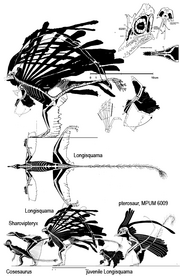
David Peters' controversial restoration of Longisquama
Other writers, with idiosyncratic views, have weighed in on Longisquama as well. David Peters, whose methods have been strongly denounced,[9] has proposed that a great deal of soft tissue and impressions of missing bones are scattered throughout the specimen, so that nearly the entire skeleton is preserved despite the specimen appearing to taper off the slab (Peters, 2006).
Contemporaries[]
Longisquama lived during the middle of the Triassic Period, also known as the "dawn of the Age of Dinosaurs", and shared the environment with a host of other animals and plants. Turtles first appeared, along with "modern" amphibians, "modern" sharks, pterosaurs, early mammals, and other animals.
Gallery[]
References[]
- ^ D.M. Unwin, M.J. Benton: Longisquama Fossil and Feather Morphology. Science, 291, 2001, S.1900-1901
- ^ T.D. Jones, J.A. Ruben, P.F.A. Maderson, L.D. Martin: Longisquama Fossil and Feather Morphology. Science, 291, 2001, S.1901-1902
- ^ D. Peters: A reexamimation of four prolacertiforms with implications for pterosaur phylogenesis. Rivista Italiana di Paleontologia e Stratigrafia, 106/3, 2000, S. 293-336
- ^ (Martin, 2004; Czerkas, 2002; Feduccia, 2005)
- ^ (Peters, 2006)
- ^ Xu, X., Zhou, Z., Wang, X., Kuang, X., Zhang, F. and Du, X. (2003). "Four-winged dinosaurs from China." Nature, 421(6921): 335-340, 23 Jan 2003. http://www.nature.com/nature/journal/v421/n6921/full/nature01342.html
- ^ Martin, Larry D. (2004) A basal archosaurian for birds. Acta Zoologica Sinica 50(6):978-990
- ^ Paul, Gregory S. (2002) Dinosaurs of the Air. Johns Hopkins University Press. Baltimore, Maryland, USA.
- ^ Bennett, S. C., 2005, "Pterosaur Science or Pterosaur Fantasy?". Prehistoric Times, No. 70, pp. 21-23 & 40
